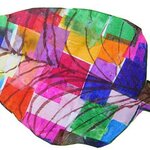Applied Physics

Scientists have successfully imaged thunder for the first time.
A team from Southwest Research Institute has visually captured the sound waves created by artificially triggered lightning, they reported at a joint meeting of American and Canadian geophysical societies in Montreal.
Although people see it as a flashing bolt, lightning begins as a complex process of electrostatic charges churning around in storm clouds. These charges initiate step leaders, branching veins of electricity propagating down, which subsequently lead to a main discharge channel. That channel opens a path to nearly…

Researchers have shown that a laser-generated microplasma in air can be used as a source of broadband terahertz radiation.
In a paper published this week in Optica, Fabrizio Buccheri and Xi-Cheng Zhang demonstrate that an approach for generating terahertz waves using intense laser pulses in air - first pioneered in 1993 - can be done with much lower power lasers, a major challenge until now. Ph.D. student and lead author Buccheri explains that they exploited the underlying physics to reduce the necessary laser power for plasma generation. He adds that it could potentially be improved for…

Researchers have used mathematical equations to shed new light on how flowing fluid hinders the movement of bacteria in their search for food. Many bacteria are mobile and inhabit a variety of dynamic fluid environments: from turbulent oceans to medical devices such as catheters.
Since the first attempts at classifying bacteria in the 17th century, shape has been an important feature, yet it is still not fully understood how shape affects the ability of bacteria to navigate their environments.
Bacteria can change their swimming direction when they encounter a chemical cue which allows them to…

How does our auditory system represent time within a sound? A new study investigates how temporal acoustic patterns can be represented by neural activity within auditory cortex, a major hub within the brain for the perception of sound.
Dr. Daniel Bendor, from University College London, describes a novel way that neurons in auditory cortex can encode temporal information, based on how their excitatory and inhibitory inputs get mixed together.
Your car moves when you press the accelerator and stops when you step on the brakes. In much the same way, a neuron's activity depends on the excitation…
The two heaviest
naturally occurring radioactive elements (by atomic weight) on the earth are Uranium and
Thorium. Uranium is used as a fuel in
modern commercial nuclear power reactors for electricity generation. A lesser known fact is that thorium could
also be used as a nuclear fuel .
Naturally occurring thorium is not fissile and so not able to undergo
nuclear fission (separation) and as such it takes an initial nuclear reaction
to enable this process.
Thorium only occurs
naturally in the form of the isotope Thorium-232 (232Th). This means that along with 90 protons…

Thermoluminescence is used on sediment 'grains', which function as natural radiation dosimeters when buried with defects or impurities, to determine age. The valid range is 1,000 to 500,000 years and the technique is used extensively in archeology and earth sciences to date artifacts and rocks.
When exposed to radiation, quartz emits light proportional to the energy it absorbs. Replicating the very low dose of background radiation from natural sources present in quartz is a key precondition for precise and accurate dating results. Italian scientists have now developed a method to control the…

Scientists have achieved an unprecedented level of control over defects in liquid crystals that can be engineered for applications in liquid matter photonics. They can lasso an intangible ring created out of liquid crystal defects - attaching a microsphere to a long thin fiber using optical tweezers.
Liquid crystals are familiar to us from their application in LCD screens. What makes them so interesting is that they are rich in defects. Thanks to advances in manipulation tools such as optical tweezers, the authors were able to create an arbitrary number of defect pairs on a long…

In 2005, scientists studying tiny sac-like creatures called sea squirts found bacteria containing two types of chlorophyll (a and b) in cavities inside the squirts' tissues.
Those two pigments were soaking up most of the sunlight - the violets, indigos, blues, green, yellows and oranges - and all that filtered through the squirts was deep red light. On the underside of the squirts was a film of photosynthesizing microbes and they turned out to be full of chlorophyll d, a rare variant of the chlorophyll molecule that absorbs near-infrared light.
By tinkering with the chlorophyll…

The Nobel Prize-winning Higgs boson – the “God particle” - believed to be vital for understanding all of the mass in the universe, was found in 2012 at CERN’s Large Hadron Collider, but that's not where the search began.
Instead, the first hint of the boson was inspired by studies of superconductors – a special class of metals that, when cooled to very low temperatures, allow electrons to move without resistance. The discovery of the Higgs boson verified the Standard Model, which predicted that particles gain mass by passing through a field that slows down their movement through the…

Milk has a long been a nutritional and economic staple in western countries but it is quickly susceptible to pathogens quite easily, which is why pasteurization, which kills harmful microbes, is the norm for all but the food fad fringes. Due to harmful microbes, raw milk is 150X as likely as pasteurized milk to result in illness.
Refrigeration and chemicals can manage pathogen growth but Listeria monocytogenes are less sensitive to low temperature; therefore, they can proliferate at refrigeration during transportation and storage. And not everyone has access to the infrastructure…